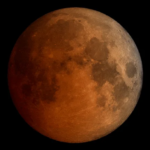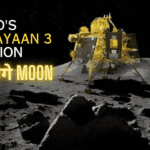The Indian Space Research Organisation (ISRO) has achieved a significant milestone by acquiring the first scientific data from the unknown southern polar region of the Moon through its Chandrayaan-3 mission, marking a significant success for the space agency.
During the thermal probe investigation conducted by the Vikram Lander, it was recorded how the temperature changes on the surface, near the surface, and in the depths of the Moon’s surface.
ISRO mentioned that the Chandrayaan-3’s Chaste (Chandra’s Surface Thermo-physical Experiment) measures the thermal behavior of the lunar surface, assessing the temperature profile of the uppermost soil layers around the lunar poles.
This investigation involves a controlled entry mechanism equipped with ten high-precision thermal sensors capable of descending up to 10 centimeters beneath the surface. The findings are depicted on a graph that illustrates the varying temperatures around the Moon’s subsurface and near-surface areas. This marks the first such profile for the southern polar region of the Moon, with detailed analysis currently underway.
ISRO’s scientist Bhm Dharukesa stated that the recorded temperatures were surprisingly higher than expected. He referenced the graph, stating, “We thought the temperature on the surface could be around 20-30 degrees Celsius, but it’s 70 degrees.”
Science Minister Jitendra Singh mentioned that the Chandrayaan-3 mission holds the promise of sending back information about the Moon’s exosphere, soil, and minerals. This mission could potentially be a breakthrough for the global scientific community. He stated, “The low density of regolith and high thermal insulation enhance its capability to serve as a fundamental building block for future habitats, while understanding the temperature variability for survival is crucial.”
Vikram Lander carries a prominent instrument, Chaste-10, equipped with high-precision thermal sensors. It will investigate temperature variation in the first ten centimeters of the lunar surface. Lunar temperatures undergo significant changes during the day and night. Around half of the Moon’s surface experiences a minimum temperature below 100 degrees Celsius, while maximum temperatures exceed 100 degrees Celsius during the day.
The upper lunar crust, around 5-20 meters thick, is expected to act as an excellent insulator. Due to the absence of atmosphere and the unique characteristics of the upper lunar surface and regolith, there is a significant expectation of substantial temperature differences between the lunar surface and the interior of the regolith.
What’s truly astonishing is that the recorded temperatures surpassed expectations. The graph revealed that temperatures on the lunar surface can reach up to 70 degrees Celsius, a stark contrast from the initial estimates of around 20-30 degrees Celsius. These findings highlight the dynamic nature of lunar thermal conditions and contribute to our understanding of the Moon’s geology and environment.
This success has not only added to ISRO’s list of achievements but also carries substantial scientific implications. By unraveling the mysteries of the Moon’s thermal behavior, ISRO’s Chandrayaan-3 mission has taken a significant step towards comprehending the Moon’s geological history, its potential for supporting future lunar habitats, and much more.
ISRO’s dedication to lunar exploration continues to expand our horizons and enrich our understanding of the celestial bodies beyond Earth.
Vikram Lander landed on August 23, making India the only country to have successfully landed in the southern polar region of the Moon. The touchdown site was later named “Shiv Shakti Point.”
India on Wednesday scripted history as ISRO’s ambitious third Moon mission Chandrayaan-3’s Lander Module (LM) touched down on the lunar surface, making it only the fourth country to accomplish the feat, and first to reach the uncharted south pole of Earth’s only natural satellite.
ISRO mentioned on Saturday that Chandrayaan-3 has three objectives :-
– soft landing .
-rover mobility on the Moon’s surface .
– in-situ scientific experiment is currently underway .
Another Post Links :-
https://onworldsnews.com/https-onworldsnews-com-trump-faces-new-challenge/













